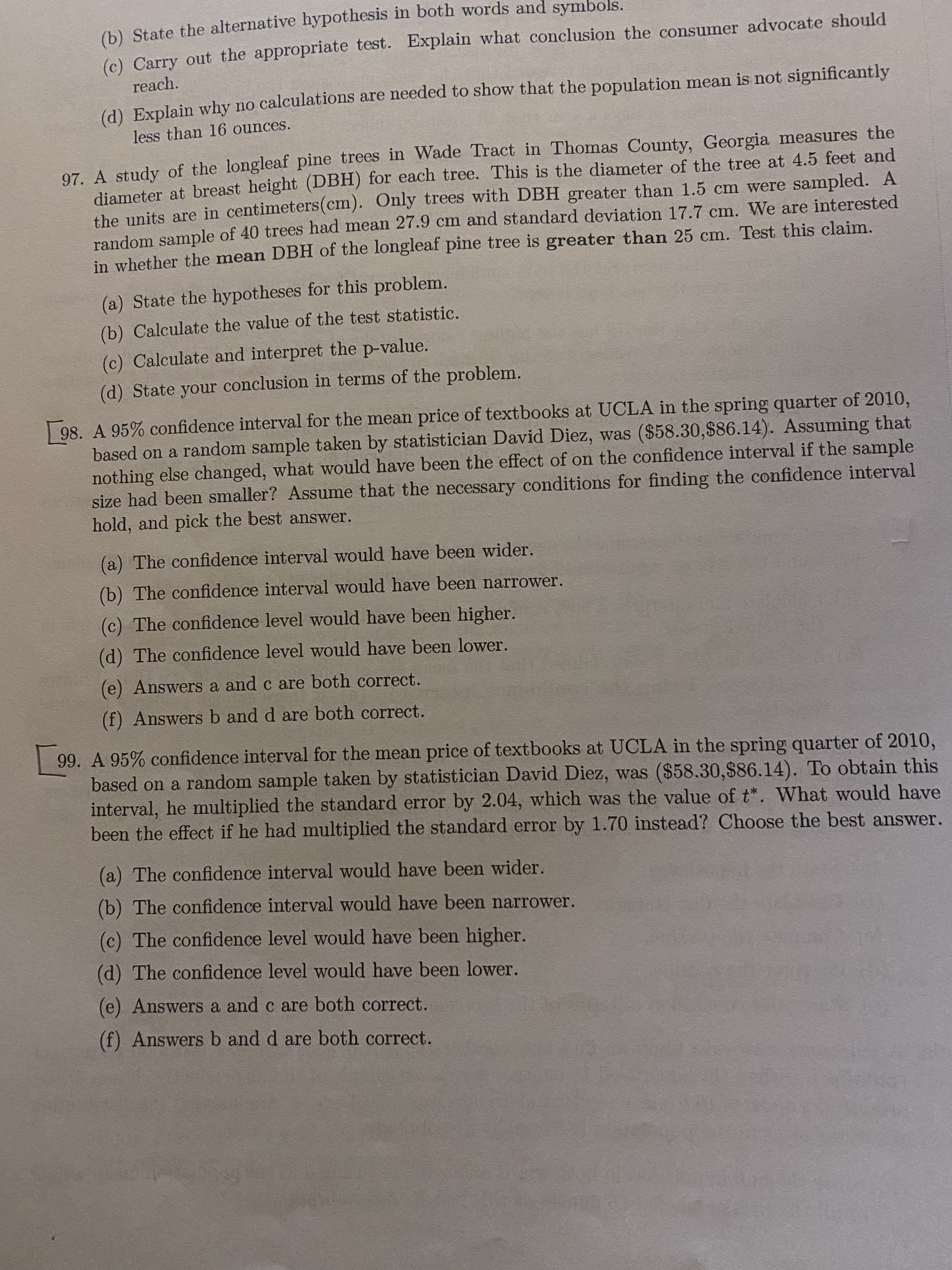(6) State the alternative hypothesis in both words and symbols. (c) Carry out the appropriate test. Explain what conclusion the consumer advocate should reach. (d) Explain why no calculations are needed to show that the population mean is not significantly less than 16 ounces. 97. A study of the longleaf pine trees in Wade Tract in Thomas County, Georgia measures the diameter at breast height (DBH) for each tree. This is the diameter of the tree at 4.5 feet and the units are in centimeters(cm). Only trees with DBH greater than 1.5 cm were sampled. A random sample of 40 trees had mean 27.9 cm and standard deviation 17.7 cm. We are interested in whether the mean DBH of the longleaf pine tree is greater than 25 cm. Test this claim. (a) State the hypotheses for this problem. (b) Calculate the value of the test statistic. (c) Calculate and interpret the p-value. (d) State your conclusion in terms of the problem. 98. A 95% confidence interval for the mean price of textbooks at UCLA in the spring quarter of 2010, based on a random sample taken by statistician David Diez, was ($58.30,$86.14). Assuming that nothing else changed, what would have been the effect of on the confidence interval if the sample size had been smaller? Assume that the necessary conditions for finding the confidence interval hold, and pick the best answer. (a) The confidence interval would have been wider. (b) The confidence interval would have been narrower. (c) The confidence level would have been higher. (d) The confidence level would have been lower. (e) Answers a and c are both correct. (f) Answers b and d are both correct. 99. A 95% confidence interval for the mean price of textbooks at UCLA in the spring quarter of 2010, based on a random sample taken by statistician David Diez, was ($58.30,$86.14). To obtain this interval, he multiplied the standard error by 2.04, which was the value of t*. What would have been the effect if he had multiplied the standard error by 1.70 instead? Choose the best answer. (a) The confidence interval would have been wider. (b) The confidence interval would have been narrower. (c) The confidence level would have been higher. (d) The confidence level would have been lower. (e) Answers a and c are both correct. (f) Answers b and d are both correct.
Unitary Method
The word “unitary” comes from the word “unit”, which means a single and complete entity. In this method, we find the value of a unit product from the given number of products, and then we solve for the other number of products.
Speed, Time, and Distance
Imagine you and 3 of your friends are planning to go to the playground at 6 in the evening. Your house is one mile away from the playground and one of your friends named Jim must start at 5 pm to reach the playground by walk. The other two friends are 3 miles away.
Profit and Loss
The amount earned or lost on the sale of one or more items is referred to as the profit or loss on that item.
Units and Measurements
Measurements and comparisons are the foundation of science and engineering. We, therefore, need rules that tell us how things are measured and compared. For these measurements and comparisons, we perform certain experiments, and we will need the experiments to set up the devices.
Number 99 part A, B, and C

Trending now
This is a popular solution!
Step by step
Solved in 2 steps with 1 images







